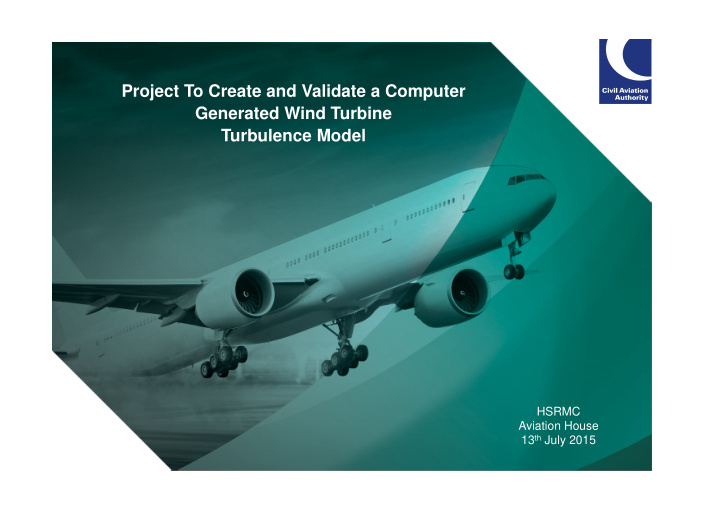



Project To Create and Validate a Computer Generated Wind Turbine Turbulence Model HSRMC Aviation House 13 th July 2015 1
Introduction • Presenter • CAA’s Environmental Programme • Background • Project Outline • Output • Next Steps • Any Questions? 2
Presenter Stephen Wheeler Civil Aviation Authority Safety and Airspace Regulation Group Intelligence, Strategy and Policy Air Traffic Management Tel: 01293 57 3819 Email: Stephen.wheeler@caa.co.uk 3
CAA Environmental Programme • Is a high level document that outlines the CAA’s environmental objectives until 2016. It can be found at: http://www.caa.co.uk/docs/2248/CAA_and_the Environment_final.pdf • Each area of the CAA has specific environmental objectives within the programme • Area responsible for this project is: Safety and Airspace Regulation Group Intelligence, Strategy and Policy Air Traffic Management 4
Background • Why Undertake this Project? Observed rise in the number of aerodromes voicing concerns regarding their perception of the possible effects of wind turbine turbulence on their operations Greater proliferation of wind turbines in more densely populated areas and those areas used by aviation Completion of a Safety Review by the CAA into the establishment of two wind turbines at East Midlands Airport 5
• What were we endeavouring to achieve? To obtain a greater knowledge and provide high quality impartial evidence regarding wind turbine turbulence. The CAA commissioned a project undertaken by Liverpool University - Integrated Simulation of Light Aircraft Encounter With Helicopter and Wind Turbine Wakes An initial element of this wider project resulted in the creation of a model outlining the nature of the turbulence associated with wind turbines Whilst the creation of this model was a step in the right direction, the data would not be able to be released into the public domain and hence used as a resource for wind turbine and aviation industries alike, until validated To ensure the model could be validated as soon as possible and to ensure that the data released was of the highest quality possible it became evident that the use of a LIDAR would be the most efficient and effective method of achieving these objectives Therefore a separate project outside of the original project was needed to validate of the Liverpool University model. 6
Project Outline • The project consisted of the following stages: Creation of a Computational Fluid Dynamics (CFD) diagram Validation of the CFD model Selection of a suitable LiDAR System o Galion Lidar - Provided by SgurrEnergy, Glasgow. Request for funding o Fund Management Board - AIFCL– One-off payment. Selection of a suitable location o East Midlands Airport – Manchester Airlines Group Selection of a suitable time of year o Undertaken after consultation with the Meteorological Office to attain, via historical data, the best time of year to ensure the wind speeds needed to validate the model . 7
o Installation of the LiDAR at the project site The Galion Lidar is relatively small and mobile (only 83kg) therefore the installation and site calibration time is short i.e. A day or two o Turbulence monitoring period LiDAR left in situ for the monitoring process to begin o Assessment of data output Liverpool University will complete this aspect of the project Flight Trials Model Peer Reviewed 8
Output • What was it hoped that the project would deliver? An independently commissioned, high quality, fully validated, peer reviewed model, outlining the length and nature of the turbulence associated with wind turbines for a wide variety of wind speeds • Where has and will this be published? The CAA has released the final report into the public domain via IN- 2015/038 Wind Turbine Wake Encounter Study on 8 May 2015 http://www.caa.co.uk/application.aspx?catid=33&pagetype=65&appid=11&mo de=detail&id=6756 CAP 764 Resulted in amended guidance for those wishing to undertake renewable developments on or near aerodromes 9
10 Aeronautical Information Publication
11
Next Steps • Year Long Research Project On A Larger Wind Turbine • Flights through wind turbine turbulence to find out likely effects? Helicopter Simulated Possibly real Fixed Wing 12
Collaborative Approach Leadership and Part Funding - Aviation Industry - Stephen Wheeler - CAA • Project Lead Project Funding - Wind Industry - Simon Heyes Chairman Fund Management • Board Turbulence Data Assessment and Modelling - Liverpool University - George • Barakos – Academic Director School Of Engineering Project Location - Aviation Industry - East Midlands Airport - Simon Whitby - • Flight Operations Director/ Mark Chambers - Engineering Manager Project Equipment - Wind Industry - Galion Lidar- SgurrEnergy - Gordon Mina – • Technical Engineer 13
14 Any Questions?
Recommend
More recommend